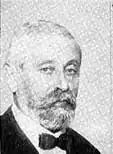Jozsef Wolfner (Arad, June 5, 1856; Budapest, February 16, 1932) was a Hungarian publisher, founder of the publishing house Singer and Wolfner.
"He was a bourgeois, and in Hungary there are bourgeois, proletarians and Bohemians, but the real bourgeois is not common. Wolfner was a real bourgeois whose lifestyle was the dignity and enthusiasm for his job. He perfectly adhered to Baudelaire’s expression that stated: "You have to work, because work is less boring than fun." Well, Wolfner was a man who was never bored. His life was dedicated to design and creativity". - From Ferenc Herceg’s memorial speech

Life
Little is known about Jozsef Wolfner’s life. In 1885, after completing his university studies, he founded along with Sandor Singer the publishing house Singer and Wolfner which was mainly devoted to literary works for children.[1] In 1923 Wolfner transformed the publishing house into a joint stock company assuming the role of President and Director.[2] Singer and Wolfner became soon well known for its works on economic issues and for the publication of significant journals and books.[3] The library was located in Budapest, at 16 Andrassy Street. The publisher’s office was on the top floor of the same building.
Editorial politics
At the beginning of the twentieth century Jozsef Wolfner was a successful businessman and well known and respected as an erudite man of letters.[4] The formula to his success was his ability to quickly perceive the needs of readers. Among the authors published by Singer and Wolfner were Ferenc Herczeg,[5] Géza Gárdonyi, Kalman Csátó, Miklos Suranyi, along with Beniczky Bajza Lenke and Hedwig Courths-Mahler.[6]
Wolfner's attention was mainly directed to the taste of the local middle class and the intellectual bourgeois. This literature was suitable for young adults since the books were simple, easy to read and in paperback formats.[7] The most successful works were those by Lajos Posa and Zsigmond Sebok.
The publishing house became also famous for its founder's passion for art collecting and patronage.[8] The latter's son, István Farkas, a famous and recognized painter,[9] followed the path of his father by becoming an art collector and patron as well. He collaborated with Jenő Barcsay, Gyula Hincz, Lajos Szalay and Tibor Vilt. Farkas was also the publishing house Director from 1932 to 1944 when Singer and Wolfner assumed the name of Literary Institute of Modern Times.
Publications
- 1885: Series of novels for adults (1885 -1931). Until 1917, published more than 500 volumes.
- 1889: My newspaper - magazine for children. Editor Lajos Posa.
- 1889: Economic Library - collection of notebooks for boys (350 volumes).
- 1895: Modern Times - illustrated weekly magazine of art and classical literature for readers of the middle-class conservative. Editor: Ferenc Herczeg. The employees were writers Sandor Brody and Gardonyi Geza Kalman and Mikszath. After 1945 the editor was the poet Jozsef Fodor that, for the first two numbers, collaborated with Lajos Kassak. The magazine was published until 1949.
- The encicopledia of modern times - in version 12 and 24 volumes.
- 1895: Hungarian Girls - magazine for teenage girls. Editor Anna Tutsek.
- 1902: Art Magazine.
- 1911 Weekly magazine Hungarian Observatory.
- 1915: Book of Millions.
- 1930: The Art Hongrois. Art publishing Franco-Hungarian about major Hungarian painters. Editor Francois Gachot. Edited volumes: József Rippl-Rónai, Tivadar Kosztka Csontváry, István Nagy, Gyula Derkovits, Jozsef Egry.
Special editions
- Lajos Bíró
- Sándor Bródy
- Imre Farkas
- Pal Farkas
- Geza Gardonyi
- Ferenc Herczeg: all the works - 1926 special edition of commemoration.
- Gyula Krúdy
- Karoly Lovik
- Gyorgy Lorinc
- Lajos Posa
- Mihaly Szabolcska
- Istvan Szomahazy
- Bela Toth:Anecdotes in six volumes.
- Ferenc Gaspar: Around the earth. Prestigious geographical works.
See also
References
- ↑ History of the Literary Cultures of East-Central Europe: Junctures and Disjunctures in the 19th and 20th Centuries, Volume 3, Marcel Cornis-Pope, John Neubauer 2007
- ↑ Magyar Zsido Lexicon, 1929, Peter Ujvary
- ↑ Magyar Zsido Lexicon, 1929, Peter Ujvary
- ↑ Katalin S. Nagy: Farkas István. Budapest, 1994
- ↑ Herczeg Ferenc: Literatur im Kontext Archived 2013-09-27 at archive.today
- ↑ István Farkas, Painter, Books and Magazines Publisher, an Outstanding Representative of the Twentieth Century Hungarian and European Paintings and my Savior during the Siege of Budapest by Andrew P. Fodor 2013
- ↑ Alessandra Farkas: Pranzo di Famiglia, Sperling&Kupfer Editori, 2006 ISBN 88-200-4059-X
- ↑ Katalin S. Nagy, Imre Kertész: The Farkas Villa, Beiträge im Ausstellungskatalog des Historischen Museums Budapest, 2005
- ↑ Katalin S. Nagy, Imre Kertész: The Farkas Villa, Beiträge im Ausstellungskatalog des Historischen Museums, Budapest 2005
Further reading
- Révai Nagylexikon
- Fábri Anna: Írók, költők, törzshelyek. In: Budapesti Negyed 1993/1.
- Fülöp Géza: A magyar könyvkultúra története 1945-ig. In: Könyvkiadók és könyvterjesztők Magyarországon. Budapest. 1987.
- Galli Katalin: A könyv története II. 1550-től a 20. század közepéig. Budapest: Hatágú Síp Alapítvány. 2005.
- Kókay György: A könyvkereskedelem Magyarországon. Budapest: Balassi Kiadó. 117.o.
- Jozsef Wolfner (8 genn.1856 -16 febb. 1932).(Edizione commemorativa) Singer e Wolfner 1932 – Discorso commemorativo di Ferenc Herczeg.
- Alessandra Farkas: Pranzo di Famiglia, Sperling&Kupfer Editori, 2006 ISBN 88-200-4059-X.
- Elhunyt Wolfner József.
- Magyar Zsido Lexicon
External links
- Magyar életrajzi lexikon http://mek.oszk.hu/00300/00355/html/ABC16920/17141.htm
- Elek Artúr: Elhunyt Wolfner József = Nyugat 1932/5. http://www.epa.oszk.hu/00000/00022/00532/16615.htm
- Mostra su István Farkas all'Accademia d'Ungheria a Roma.
- Al Vittoriano a Roma le opere del pittore ungherese István Farkas Adnkronos 14 settembre 2002.
- La storia della famiglia Farkas. Il talento e la cultura di una famiglia ungherese Adnkronos - 22 luglio 2006
- Pranzo di famiglia di Alessandra Farkas Mosaico - CEM - 17 Aprile 2006